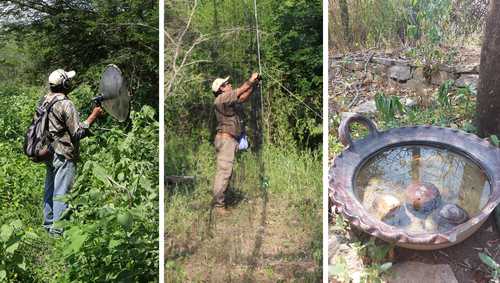There is no precise data on the species of birds affected or the number of specimens killed by the heat waves that have been recorded in most of the Mexican territory, agreed experts in avian medicine consulted by The Day.
They added that the attention to the emergency has fallen mainly on civil society, especially on biologists and naturalists, who have independently undertaken actions to protect specimens diminished by the heat, such as installing drinking fountains in nature reserves and green areas of public institutions and households.
Fernando González-García, from the Faculty of Sciences of the National Autonomous University of Mexico (UNAM) and member of the AC Institute of Ecology, said that in various parts of the country, episodes of birds falling dehydrated from trees have multiplied and must be helped by humans to try to recover.
The emergency occurs from the Huasteca region of San Luis Potosí, where birds recover from dehydration in air-conditioned rooms, to the central area of Veracruz, where naturalists have had to hire pipes to fill natural reservoirs and provide water to the birds and the rest of the fauna of the region.
“The mortality of birds is due to the heat dome that is over the country and the scarcity of water, but, unlike the howler monkeys – another species that also recorded mortality due to high temperatures – in this case we have no data precise details of the dimension of the affectation,” stressed the specialist.
Necessary, change habits
After learning that in San Luis Potosí and Tamaulipas, where temperatures of 40 degrees caused the death of parrots and orioles, researchers from the Institute of Ecology decided to foresee and placed drinking fountains in the green areas of the campus, in the Bosque de Niebla Sanctuary, in the central area of Veracruz, and even on the roofs of their homes.
Birds are in a very adverse situation if we consider the high temperatures, in combination with the loss of habitats, and the drought
said González-García, who considered: We have to sensitize the population to this circumstance, to change behaviors, consumption, the way of living.
.
Aurelio Molina Hernández, specialist in bird observation and identification at Pronatura and the Xocotitla Natural Reserve – the latter, in Paso de Ovejas, Veracruz dedicated to the conservation of the Elisa hummingbird (doricha eliza), national endemic species, stated that 2024 has been a very complicated year due to water scarcity.
For example, in the Xocotitla reserve, of 106 hectares, they had to hire a pipe to supply a natural reservoir that was almost dry due to the lack of rain and evaporation due to high temperatures, in order to guarantee water for the fauna of the region.
The natural reservoirs that we have are only filled in the rainy season, but since the years of drought have been consecutive plus the heat waves, the water quickly ran out, and we have to look for alternatives, such as transporting it with vehicles in pipes or with horses. . The shortage in the area is very strong
highlighted Molina Hernández.
After refilling the glass, the place became a party
: Specimens of various species arrived: cardinals, calandrias, black-headed coas, cinnamon-naped rails, luises bienteveo and purple buntings to hydrate themselves. Mammals that live in the area also approached.
The site has become a sanctuary, an oasis, because the animals take refuge and hunting is not allowed.
Meanwhile, Mariemma Escorcia Quintana, a zootechnical veterinarian from UNAM and dedicated to the wildlife clinic with an emphasis on avian medicine, said that in the northern area of Veracruz, where temperatures have reached 48 degrees, they have received specimens of yellow-cheeked parrots. , dirty-breasted parakeets and baby owls with signs of dehydration.
“This heat wave coincides with a stage of birth of different species of birds, which makes them much more susceptible to weakening, because these are individuals that are learning to adapt to life in the wild.
When they leave the nest they have to learn to look for food resources, water and guard against predators, and under these conditions of high temperatures and drought, the species are moving more to hydrate or feed, and that weakens them a lot.
Escorcia Quintana, a member of the Association of Doctors Specialized in Avian Medicine in Mexico, described that a bird with heat stroke presents signs such as a state of disorientation, drooping or extended wings and constant panting.
The best thing to do when identifying a bird in these conditions, he said, is to remove it from the direct rays of the sun, without causing an abrupt change in temperature, and call a specialist, because if you try to force them to eat or drink they can suffocate.
